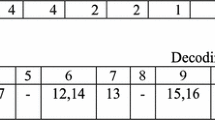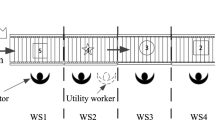Abstract
This paper introduces a two-stage assembly flowshop scheduling model with time cumulated learning effect, which exists in many realistic scheduling settings. By the time cumulated learning effect, we mean that the actual job processing time of a job depends on its scheduled position as well as the processing times of the jobs already processed. The first stage consists of two independently working machines where each machine produces its own component. The second stage consists of a single assembly machine. The objective is to identify a schedule that minimizes the total completion time of all jobs. With analysis on the discussed problem, some dominance rules are developed to optimize the solving procedure. Incorporating with the developed dominance rules, a dominance rule and opposition-based particle swarm optimization algorithm (DR-OPSO) and branch-and-bound are devised. Computational experiments have been conducted to compare the performances of the proposed DR-OPSO and branch-and-bound through comparing with the standard O-PSO and PSO. The results fully demonstrate the efficiency and effectiveness of the proposed DR-OPSO algorithm, providing references to the relevant decision-makers in practice.





Similar content being viewed by others
References
Al-Anzi FS, Allahverdi A (2013) An artificial immune system heuristic for two-stage multi-machine assembly scheduling problem to minimize total completion time. J Manuf Syst 32(4):825–830
Biskup D (1999) Single-machine scheduling with learning considerations. Eur J Oper Res 115:173–178
Biskup D (2008) A state-of-the-art review on scheduling with learning effect. Eur J Oper Res 188:315–329
Fattahi P, Hosseini SMH, Jolai F, Reza TM (2014) A branch and bound algorithm for hybrid flow shop scheduling problem with setup time and assembly operations. Appl Math Model 38(1):119–134
Ignall E, Schrage LE (1965) Application of the branch and bound technique to some flowshop scheduling problems. Oper Res 13:400–412
Janiak A, Krysiak T, Trela R (2011) Scheduling problems with learning and ageing effects: a survey. Decis Mak Manuf 5(1–2):19–36
Ji M, Tang X, Zhang X, Cheng TCE (2016) Machine scheduling with deteriorating jobs and DeJong’s learning effect. Comput Ind Eng 91(C):42–47
Jung S, Woo YB, Kim BS (2017) Two-stage assembly scheduling problem for processing products with dynamic component-sizes and a setup time. Pergamon Press, Inc, New York
Komaki GM, Kayvanfar V (2015) Grey Wolf Optimizer algorithm for the two-stage assembly flow shop scheduling problem with release time. Journal of Computational Science 8:109–120
Koulamas C, Kyparisis GJ (2007) Single-machine and two-machine flowshop scheduling with general learning functions. Eur J Oper Res 178:402–407
Lee CY, Cheng TCE, Lin BMT (1993) Minimizing the makespan in the 3-machine assembly-type flowshop scheduling problem. Manag Sci 39:616–625
Liu Y, Feng Z (2014) Two-machine no-wait flowshop scheduling with learning effect and convex resource-dependent processing times. Comput Ind Eng 75:170–175
Lu YY, Wei CM, Wang JB (2012) Several single-machine scheduling problems with general learning effects. Appl Math Model 36(11):5650–5656
Mirjalili S, Jangir P, Mirjalili SZ, Saremi S, Trivedi IN (2017) Optimization of problems with multiple objectives using the multi-verse optimization algorithm. Knowl-Based Syst 134:50–71
Niknamfar AH, Niaki STA, Niaki SAA (2017) Opposition-based learning for competitive hub location: a bi-objective biogeography-based optimization algorithm. Knowl-Based Syst 128:1–19
Torabzadeh E (2010) Cloud theory-based simulated annealing approach for scheduling in the two-stage assembly flowshop. Adv Eng Softw 41(10):1238–1243
Wang JB, Wang JJ (2015) Research on scheduling with job-dependent learning effect and convex resource-dependent processing times. Int J Prod Res 53(19):1–11
Wang XY, Zhou Z, Zhang X, Ji P, Wang JB (2013) Several flow shop scheduling problems with truncated position-based learning effect. Comput Oper Res 40(12):2906–2929
Wang XR, Wang JB, Jin J, Ji P (2014) Single machine scheduling with truncated job-dependent learning effect. Optim Lett 8(2):669–677
Wong TC, Ngan SCA (2013) comparison of hybrid genetic algorithm and hybrid particle swarm optimization to minimize makespan for assembly job shop. Appl Soft Comput 13(3):1391–1399
Wu CC, Cheng SR (2013) Single-machine and two-machine flowshop scheduling problems with truncated position-based learning functions. J Oper Res Soc 64(1):147–156
Xiong F, Xing K (2014) Meta-heuristics for the distributed two-stage assembly scheduling problem with bi-criteria of makespan and mean completion time. Int J Prod Res 2(9):2743–2766
Xu J, Wu CC, Yin Y, Zhao C, Chiou YT, Lin WC (2016) An order scheduling problem with position-based learning effect. Comput Oper Res 74(C):175–186
Yin Y, Xu D, Sun K, Li H (2009) Some scheduling problems with general position-dependent and time-dependent learning effects. Inf Sci 179:2416–2425
Yin Y, Xu D, Wang J (2010a) Some single-machine scheduling problems past-sequence-dependent setup times and a general learning effect. Int J Adv Manuf Technol 48:1123–1132
Yin Y, Xu D, Wang J (2010b) Single-machine scheduling with a general sum-of-actual-processing-times-based and job-position-based learning effect. Appl Math Model 34:3623–3630
Yin Y, Xu D, Huang X (2011) Notes on “Some single-machine scheduling problems with general position-dependent and time-dependent learning effects”. Inf Sci 181:2209–2217
Yin Y, Liu M, Hao J, Zhou M (2012a) Single machine scheduling with job position-dependent learning and time-dependent deterioration. IEEE Trans Syst Man Cybern A Syst Hum 42:192–200
Yin Y, Wu C-C, Wu W-H, Cheng S-R (2012b) The single-machine total weighted tardiness scheduling problem with position-based learning effects. Comput Oper Res 39:1109–1116
Funding
This paper was funded in part by the National Natural Science Foundation of China (Nos. 71501024, 71871148), by Taiwan’s Ministry of Science and Technology (No. MOST105-2221-E-035-053-MY3), by China Postdoctoral Science Foundation (Nos. 2018T110631, 2017M612099), and by Sichuan University (No. 2018hhs-47).
Author information
Authors and Affiliations
Corresponding author
Ethics declarations
Conflict of interest
All of the authors declare that they have no conflict of interest.
Human participants or animals
This paper does not contain any studies with human participants or animals performed by any of the authors.
Additional information
Communicated by V. Loia.
Appendix: Dominance rule-based branch-and-bound algorithm
Appendix: Dominance rule-based branch-and-bound algorithm
A branch-and-bound algorithm systematically and comprehensively searches an enumerated set of solution candidates which is consider as a full set of rooted tree. The algorithm searches out each subset (or branch) of this solution set (or tree). Each subset is examined with estimated lower and upper bounds of the optimal solution. In enumerating the subset of solution candidates, those cannot yield a solution better than the best already found by the algorithm are discarded.
The branching procedure adopts depth-first search in Fig. 6, which has the advantage of requiring the computer to store no more than (n − 1) nodes for the lower bounds throughout the procedure. Beginning with the first position, the algorithm allocates jobs in a forward manner. In the process, we select a branch and systematically search down the tree. Adopting the similar ideas from Ignall and Schrage (1965) and Lee et al. (1993), a lower bound can be obtained as follows.
Note that pi(0) = 0, i = 1, 2, 3.
The branch may be eliminated by the pair of lower and upper bounds or the dominance properties. Otherwise, when reaching its final node, the sequence is likely to replace the initial solution or is removed, which depends on the quality of this current solution. The details are provided as follows:
Step 1 | Initialization Perform the standard PSO algorithm to obtain a sequence as the initial solution |
Step 2 | Branching Use the depth-first search strategy |
Step 3 | Eliminating Use Properties 1 to 7 to eliminate the dominated partial sequences. For the non-dominated nodes, use Properties 8 to 10 to check whether the order of the unscheduled jobs can be directly determined by SPT |
Step 4 | Bounding Calculate the lower bound according to the introduced formula If the result is greater than the initial solution, eliminate that node and all nodes beyond it in the branch. Otherwise, replace it as a new solution |
Step 5 | Termination Repeat steps 3–4 until no more nodes left |
Rights and permissions
About this article
Cite this article
Wang, D., Qiu, H., Wu, CC. et al. Dominance rule and opposition-based particle swarm optimization for two-stage assembly scheduling with time cumulated learning effect. Soft Comput 23, 9617–9628 (2019). https://doi.org/10.1007/s00500-018-3525-y
Published:
Issue Date:
DOI: https://doi.org/10.1007/s00500-018-3525-y





